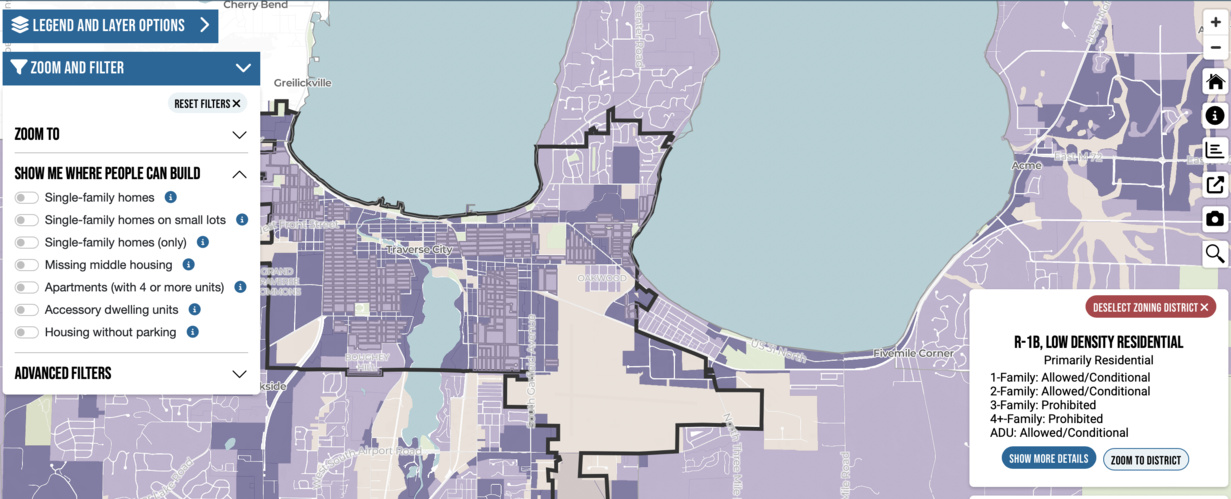
Zoning Atlas Unveiled for Grand Traverse County
By Beth Milligan | June 25, 2025
A new tool to help address local housing needs will be unveiled this week in Traverse City. Housing North and the Grand Traverse County Economic Development Corporation (EDC) will host a public open house Thursday to demonstrate Grand Traverse County’s new zoning atlas, an interactive map offering an easy visual guide to local zoning regulations – showing where different types of housing can be built (or not) and opportunities for future growth in each community.
The project aims to translate complex zoning codes into “easily understandable data and maps,” according to Housing North’s website. With funding support from the EDC and Brookby Foundation, Housing North partnered with Flywheel Companies, the University of Michigan, and the Michigan Association of Planning to create Grand Traverse County’s zoning atlas. Emmet, Leelanau, and Benzie counties are next on deck this year, with the goal of creating a zoning atlas for each of the 10 Northwest Michigan counties – including Antrim, Charlevoix, Kalkaska, Manistee, Missaukee, and Wexford – by the end of 2026.
To create the zoning atlas, zoning ordinance texts and spatial data about zoning boundaries for all communities within each county are inputted into a single map, which then provides a standardized visual display of local land uses. Users, for instance, can click on individual neighborhoods within the City of Traverse City or Union Township and see how each district is zoned and what type of housing is allowed. Conversely, users can choose from a drop-down menu of housing types – such as single-family homes, apartments, or accessory dwelling units – and see where throughout Grand Traverse County such structures are permitted.
The tool also provides a “zoning snapshot” that summarizes conditions in each county, as well as each individual jurisdiction. For example, the 16 total jurisdictions in Grand Traverse County include 157 total zoning districts that were mapped and 3,489 pages of zoning text that were analyzed. Of the nearly 291,000 acres of land in the county, 73 percent is zoned – with the rest either protected, unzoned, or tribal lands. On the housing front, the snapshot makes it clear that building single-family homes is relatively easy – 97 percent of all residential land allows such homes by right – but building three or four-family structures is significantly more challenging, as they are prohibited on more than 80 percent of residential parcels. Even two-family homes are banned on more than half of the county’s residential land.
Those takeaways can help community leaders better understand “where the limitations are” for housing – and potentially make zoning changes to address those barriers, Housing North Executive Director Yarrow Brown tells The Ticker. Another phase of work now underway in Grand Traverse County will create a second community resource: a growth corridor mapping tool. That tool will help identify key areas where growth could best be concentrated, taking into consideration factors ranging from infrastructure to environmentally sensitive areas like wetlands. That map might show that some communities have their high-density zoning districts in areas that aren’t suitable for major growth – or conversely, have zoning constraints on land that could ideally be more densely developed.
“As our region continues to attract new residents, this second phase of the project is critical and will provide valuable data to communities that face continued development pressures,” says EDC Chair Kevin Endres. “Communities will be able to utilize the zoning atlas and growth mapping to help identify the areas of the county that can support higher density development.”
Brown notes that growth is “coming and inevitable” since Grand Traverse County remains such a desirable place to live. “It’s not going to stop, so how can we help communities plan for that growth and build housing for everybody?” she says. “In order to do that, we need more density options, square footage options, and so forth. We know people ultimately want to live in and own their own home, but there’s also a huge need for in-between housing.”
Brown says the zoning atlas and growth mapping tools can help communities think through not only their housing picture but surrounding community amenities – from where roads are built to how infrastructure is expanded to when new services like healthcare or schools will be needed. “It’s part of a greater economic development picture with a housing lens, because housing is the critical piece,” she says.
Housing North and the Grand Traverse County Economic Development Corporation will host a public open house on the county’s new zoning atlas Thursday, June 26 from 2:30pm to 4pm at West Shore Bank’s third floor Community Space on Eighth Street. The event will include a brief demonstration of the zoning atlas, a question-and-answer session, discussion of next steps in the project, and an optional hands-on skills lab led by the Michigan Association of Planning for participants to try out the atlas.
Comment






